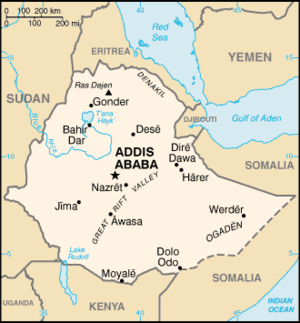OP 12 SEPTEMBER 2007 VIERT DE ETHIOPISCHE KALENDER
HET TWEEDE MILLENNIUM-FEEST.
Een Nederlandse delegatie is op weg naar Addis Abeba.
Tocht van Hoop bij
millenniumfeest van Ethiopië
DEN HAAG - Op 29 juli 2007
vertrok vanaf het Vredespaleis in Den Haag een vredekaravaan onder het motto:
‘Journey of Hope’. Initiatiefnemer is de stichting ADMAS in Amsterdam onder
leiding van een in Nederland werkzame Ethiopische priester Petros S. Berga.

Doel van de tocht is aandacht te
vragen voor de roep om vrede en ontwikkeling in Ethiopië. De karavaan bestaat
uit vijf terreinwagens en gaat dwars door Europa via het Midden-Oosten, Egypte
en Soedan naar Ethiopië. In de landen welke de ‘Journey of
Hope’ aandoet, zijn er ontmoetingen met de lokale Ethiopische gemeenschappen. Een
en ander wordt uitgewerkt in samenwerking met een aantal internationale
organisaties.
Millennium
De aankomst in Ethiopië is
gepland vóór de Ethiopische millenniumwisseling van 12 september 2007. Rond dat
Ethiopische millennium worden in meerdere belangrijke Ethiopische plaatsen
conferenties georganiseerd rond het thema mentaliteitsverandering voor vrede en
ontwikkeling. Vertegenwoordigers uit alle etnische, regionale, politieke en
religieuze bevolkingsgroepen zullen deelnemen. Na aankomst in Ethiopië worden
de auto’s aan plaatselijke ngo’s geschonken. Lokale werkgroepen zullen het
gedachtegoed van de ‘Journey of Hope’ warm houden onder bestuur en de
bevolking.
De Missionarissen van Afrika zijn werkzaam in Ethiopië:
1/ ADIGRAT. Deze stad ligt in het Noorden van het land, in de Tigray Provincie, niet ver van de grens met Eritrea.
Zij hebben daar de leiding van het St. Paul's Formation House, en het Groot Seminarie van het Bisdom Adigrat.
2/ WUKRO ligt niet ver van Adigrat. Klik op de naam, en bekijk de engels-talige site van de Witte Paters.
3/ Van 2 tot 24 september 2007 heeft in Addis Abeba de Algemene Vergadering van het "tussen-kapittel" van de Missionarissen van Afrika plaats. Een achteruit-blik, maar tevens reeds een vooruitblik naar het Algemene Kapittel van 2010. Klik hier om de foto's te bezichtigen. Dubbel-klik de foto's om ze te vergroten
HOE DE BEVOLKING OM GAAT MET HONGER.
Een Afrikaanse journalist deed ervaring op, om een paar maanden met de mensen in een afgelegen dorp van Ethiopië mee te leven en te werken.
(Het artikel is in het Engels...vertalers gevraagd svp.)
 About 'Surviving Hunger'
About 'Surviving Hunger'
In an unprecedented mission, Sorious Samura set out to understand the real stories of people living on the edge of starvation.
He moved into a remote village in Ethiopia far away from the range of the UN and most NGO's.
Between August and September Sorious lived in a hut and survived on the same meagre diet as the rest of the villagers.
As he arrived in the village Sorious got an unpleasant surprise. The villagers made it clear he was not welcome. 'They think you are the Devil' he is told. In the Ethiopian Orthodox tradition the devil indeed is usually depicted as a very black being, blacker than most villagers.
It takes Sorious much persuasion to convince the villagers that he will not eat their babies and hasn't come to rape their wives.

Very soon Sorious settles into the routine of the village. He is amazed and exhausted by the hard work he must do to keep up with the villagers as they climb steep slopes to plough and till their fields every day.
Despite the weather failing them on so many previous occasions the villagers always have hope that their next harvest will bring the food they so desperately need.
There is food aid, but never enough. Sorious is living with a family where the meagre supplies supposed to last for two months have run out in two weeks.
Now Mum and Dad, five children and Sorious must survive on a local weed called wild cabbage. A grown man would need to eat a room full of wild cabbage to satisfy a day's nutritional requirement, but the plant, even though it makes the villagers sick, fills stomachs and at least gives the sense of food.
Sorious has made friends with the deacons. Young boys who receive religious education but must beg for their school fees and for the food that they eat. Together they travel to other remote villages and eventually to the town of Lalibela to beg or to find work if they can. It is an awful journey, which brings us painfully close to the real lives of the poor.

Away from the headline making famine, award-winning filmmaker Sorious Samura discovers that the daily reality for more than 40 million Africans is a diet ranging from nothing to a handful of weeds. In his unique style of filmmaking he questions how we can expect Africa to develop when so many Africans are engaged in a daily struggle to survive.





